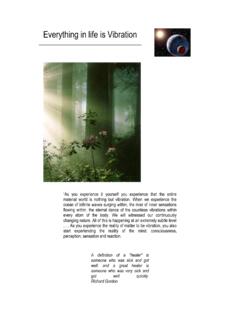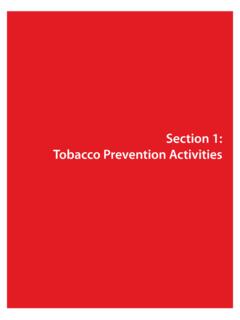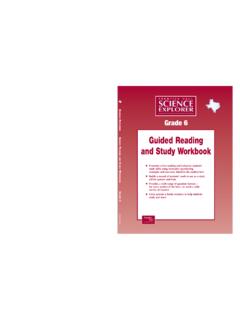Transcription of 8.3 The Process of Photosynthesis
1 Lesson Workbook A Copyright by Pearson Education, Inc., or its affi liates. All Rights Class Date The Process of PhotosynthesisLesson Objectives Describe what happens during the light-dependent reactions. Describe what happens during the light-independent reactions. Identify factors that affect the rate at which Photosynthesis SummaryThe Light-Dependent Reactions: Generating ATP and NADPH Photosynthesis begins with these reactions, which occur in thylakoid are clusters of proteins and chlorophyll in thylakoid electrons form when pigments in photosystem II absorb light.
2 The electrons pass through electron transport chains, a series of electron carrier proteins. The movement of electrons through an electron transport chain causes a thylakoid to fill up with hydrogen ions and generates ATP and NADPH. ATP synthase is a membrane protein through which excess hydrogen ions escape a thylakoid in a Process that makes Light-Independent Reactions: Producing Sugars They occur in the stroma of thylakoids and are commonly called the Calvin cycle. Six carbon dioxide molecules from the atmosphere enter the Calvin cycle and combine with 5-carbon compounds already present. They produce twelve 3-carbon 3-carbon molecules are removed from the cycle.
3 They are used by the plant to build sugars, lipids, amino acids, and other compounds. The remaining ten 3-carbon molecules are converted back to 5-carbon molecules and begin a new cycle. Factors Affecting Photosynthesis Many factors influence the rate of , light intensity, and availability of water affect Photosynthesis . C4 and CAM plants have a modified type of Photosynthesis that enables the plants to conserve water in dry Light-Dependent Reactions: Generating ATP and NADPHFor Questions 1 5, write True if the statement is true. If the statement is false, change the underlined word or words to make the statement true. 1. Photosystems are clusters of chlorophyll and proteins.
4 2. The light-dependent reactions begin when photosystem I absorbs light. 3. Electrons from water molecules replace the ones lost by photosystem II. 4. ATP is the product of photosystem I. 5. ATP and NADPH are two types of protein 81/5/09 12:00:39 PMLesson Workbook A Copyright by Pearson Education, Inc., or its affi liates. All Rights Class Date 6. How does ATP synthase produce ATP? 7. When sunlight excites electrons in chlorophyll, how do the electrons change? 8. Where do the light-dependent reactions take place? 9. Complete the table by summarizing what happens in each phase of the light-dependent reactions of ReactionsSummaryPhotosystem IIElectron Transport ChainPhotosystem IHydrogen Ion Movement and ATP Formationthylakoid membrane.
5 As the ions pass through, ATP synthase rotates. The rotation creates the energy needed to bind ADP and a phosphate group together to produce electrons take on a great deal of energy, which causes them to move to a higher energy in the thylakoid membranes inside of II absorbs light and increases the electrons energy level. The electrons are passed to the electron transport chain. Enzymes in the thylakoid break up water molecules into 2 electrons, 2 H+ ions, and 1 oxygen atom. The 2 electrons replace the high-energy electrons that have been lost to the electron transport from the electrons is used by the proteins in the chain to pump H+ ions from the stroma into the thylakoid space.
6 At the end of the electron transport chain, the electrons themselves pass to photosystem electrons do not contain as much energy as they used to. Pigments use energy from light to reenergize the electrons. At the end of a short second electron transport chain, NADP+ molecules in the stroma pick up the high-energy electrons, along with H+ ions, at the outer surface of the thylakoid membrane, to become ions began to accumulate within the thylakoid space. The buildup of hydrogen ions makes the stroma negatively charged relative to the space within the thy-lakoids. This gradient, the difference in both charge and H+ ion concentration across the membrane, provides the energy to make synthase allows H+ ions to pass through the The light-dependent reactions take 91/5/09 12:00:41 PMLesson Workbook A Copyright by Pearson Education, Inc.
7 , or its affi liates. All Rights Class Date Calvin CycleC6CO2 CCC2 CCCCCCS ugars and other compoundsATP1212 NADPHATP612 CCC12 ADP12 NADP+12 CCC10 CCC6 CCCCC6 ADPThe Light-Independent Reactions: Producing Sugars 10. What does the Calvin cycle use to produce high-energy sugars? 11. Why are the reactions of the Calvin cycle called light-independent reactions? 12. What makes the Calvin cycle a cycle? 13. Complete the diagram of the Calvin cycle by filling in the missing Calvin cycle uses carbon dioxide molecules as well as ATP and NADPH from the light-dependent reactions to make reactions of the Calvin cycle use ATP and NADPH as energy sources.
8 They do not directly require compound with which CO2 from the air combines is a product of the cycle, which enables the series of reactions to occur over and 101/5/09 12:00:43 PMLesson Workbook A Copyright by Pearson Education, Inc., or its affi liates. All Rights Class Date Factors Affecting Photosynthesis 14. What are three factors that affect the rate at which Photosynthesis occurs? 15. Would a plant placed in an atmosphere of pure oxygen be able to conduct Photosynthesis ? Explain your answer. 16. Complete the table about variations of Photosynthesis .
9 TypeDescriptionExamplesOccurs in plants that have a specialized chemi-cal pathway that allows them to capture even very low levels of carbon dioxide and pass it to the Calvin cycle. pineapple trees, many desert cacti, and ice plants 17. Photosynthesis plays an important role in supplying energy to living things. Considering what the products of Photosynthesis are, what is another way in which Photosynthesis is vital to life?C4 Photosynthesiscorn, sugar cane, and sorghumCAM CAM plants only allow air into their leaves at night which minimizes water loses. Carbon dioxide is trapped in the leaves and it is released during the day, enabling carbohydrate is the way in which new organic macromolecules are added to the living portion of the biosphere.
10 All living things that are not photosynthetic rely on Photosynthesis as a source of the organic building blocks needed for growth. Photo-synthesis also releases oxygen into the atmosphere. Without this oxygen we would not be able to factors that affect the rate of Photosynthesis are temperature, light intensity, and the availability of ANSWER: No. One of the materials that plants use in Photosynthesis is carbon dioxide. None of this gas would be present in an atmosphere of pure oxygen. There-fore, Photosynthesis could not 111/5/09 12:00:45 PMName Class Date Chapter 8 Workbook A Copyright by Pearson Education, Inc.













